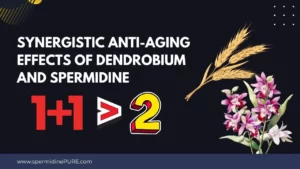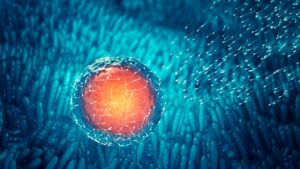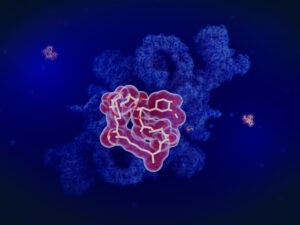In your exploration of cellular metabolism, you’ve likely come across two important polyamines, spermine and spermidine. These polyamines play essential roles in various cellular processes and can impact both plant and human physiology.
As you learn more about spermidine powder, you’ll discover its significance in regulating plant growth, assisting RNA transcription, and inhibiting nitric oxide synthase. On the other hand, spermine plays a role in cellular metabolism in all eukaryotic cells. While spermine’s unique functions are not well-documented, it is important to note that spermidine serves as a precursor to spermine.
As you delve further into this topic, you can uncover compelling findings about how spermine and spermidine have been connected to health benefits, including their potential roles in geroprotection and boosting autophagy, a natural cellular process. By understanding their functions and interactions, you can broaden your knowledge of the intricate balance within cellular metabolism.
Spermine and Spermidine: The Basics
Together, spermine and spermidine are essential polyamines that play significant roles in various cellular processes. To understand their importance, we’ll examine their chemical structure, functions in the body, and presence in the human diet.
Chemical Structure of Spermine and Spermidine
Spermine and spermidine are organic compounds that belong to the polyamine family. Both contain multiple amine functional groups, with spermidine being a triamine and spermine being a tetraamine. Here, spermine is biosynthesized from the triamine spermidine, initially produced from the diamine putrescine(American Chemical Society).
Functions of Spermine and Spermidine in the Body
These polyamines are involved in numerous cellular processes, including:
- Regulating cell growth and differentiation
- Maintaining the stability of cell membranes
- Modulating the activity of certain enzymes and other biomolecules
- Supporting the DNA and RNA synthesis
In plants, spermidine contributes to tolerance against drought and salinity(Wikipedia). They have also been implicated in erythroid colony formation and can influence erythropoietin bioactivity(ScienceDirect Topics).
Spermine and Spermidine in the Human Diet
Spermine and spermidine are present in various food sources, and their ingestion contributes to their concentration in the body. Some of the dietary sources include:
| Food Source | Spermine and Spermidine Content |
|---|---|
| Wheat germ | High |
| Legumes (soybeans, lentils, chickpeas) | High |
| Certain fruits (oranges and grapefruits) | Moderate |
| Vegetables (broccoli, cauliflower, spinach) | Moderate |
| Meat and dairy products | Varied |
Maintaining a balanced diet incorporating these food sources can promote a healthy concentration of spermine and spermidine in your body, supporting their essential roles in cellular functions.
Health Benefits of Spermine and Spermidine
Anti-Aging Properties
Spermine and spermidine have been shown to play a key role in promoting healthy aging by helping regulate autophagy, the body’s natural process of eliminating cellular waste materials (source). These polyamines can facilitate cellular detoxification and regeneration by supporting this vital cellular function, thus contributing to a longer, healthier lifespan.
Neuroprotective Effects
Through their ability to induce autophagy, spermine, and spermidine can also benefit your brain health. This neuroprotective effect aids in preventing age-related cognitive decline and memory loss (source).
Cardiovascular Benefits
Your cardiovascular health can also benefit from spermine and spermidine, as they have been shown to support overall heart health and protect against age-related cardiovascular diseases (source).
Anticancer Properties
These polyamines also demonstrate potential anticancer properties linked to their ability to support healthy cell growth and regulate the immune system (source).
Immune System Regulation
Finally, spermine and spermidine help maintain a robust immune system by regulating T cells and immunosurveillance (source).
| Benefit | Impact |
|---|---|
| Anti-Aging Properties | Promotes healthy aging through autophagy regulation |
| Neuroprotective Effects | Prevents age-related cognitive decline and memory loss |
| Cardiovascular Benefits | Supports heart health and protects against age-related cardiovascular diseases |
| Anticancer Properties | Supports healthy cell growth and regulates the immune system |
| Immune System Regulation | Strengthens immunity through the regulation of T cells and immunosurveillance |
Sources of Spermine and Spermidine
Foods Rich in Spermine and Spermidine
Many common foods contain significant amounts of spermine and spermidine. Some excellent dietary sources of spermidine include aged cheese, mushrooms, soy products, legumes, corn, and whole grains, which are abundant in a Mediterranean diet[source]. On the other hand, spermine is a polyamine found in all eukaryotic cells with its precursor coming from the amino acid ornithine[source].
Furthermore, dietary polyamines such as spermine, spermidine, and putrescine play important roles in human health, particularly in the intestinal maturation, differentiation, and development of the immune system[source]. Some spermidine-rich foods to include in your diet are:
- Hazelnuts: 2.1 mg/100 g[source]
- Cruciferous vegetables[source]
Spermine and Spermidine Supplements
While many foods contain spermine and spermidine, you may not always get enough of these nutrients through your diet alone. In such cases, supplements can provide a convenient alternative. It is important to seek professional advice before using supplements to ensure they are appropriate for your specific needs and health conditions.
How to Incorporate Spermine and Spermidine into Your Diet
To ensure you get enough of these essential nutrients, consider implementing the following dietary strategies:
- Use l-arginine-rich foods, like nuts, seeds, and legumes, to promote the synthesis of spermine and spermidine in the body.
- Focus on consuming a Mediterranean-style diet, which is abundant in spermidine-containing foods[source].
- Practice caloric restriction, linked to upregulated spermidine production[source].
- Eat various nutrient-dense whole foods, like fruits, vegetables, whole grains, lean proteins, and healthy fats, to support overall health and well-being.
Spermine and Spermidine in Disease
Role of Spermine and Spermidine in Alzheimer’s Disease
Your body utilizes spermine and spermidine to perform crucial biological functions. In the context of Alzheimer’s disease, these polyamines have been found to display protective effects against memory impairment and oxidative damage. They help to maintain cellular balance, and deficiencies in spermine and spermidine levels may contribute to the progression of Alzheimer’s.
Spermine and Spermidine in Parkinson’s Disease
In Parkinson’s disease (PD), the role of spermine and spermidine is still being researched, but there are promising initial findings. Under physiological conditions, spermidine has been shown to enhance longevity and induce autophagy(source). This autophagy-induction property could help slow PD’s progression by clearing damaged or dysfunctional cellular components from your neurons.
Spermine and Spermidine in Cancer
Spermine and spermidine levels are known to be altered in various cancers. While the exact mechanism is unclear, these polyamines are believed to play a role in cell proliferation and differentiation. It’s important to note that their relationship with cancer is complex and requires further investigation, as some studies suggest that high concentrations of spermidine might promote cancer growth in advanced stages(source), while other research indicates a potential role in cancer therapy by sensitizing cancer cells to the effects of specific treatments.
Spermine and Spermidine in Autoimmune Disorders
The involvement of spermine and spermidine in autoimmune disorders is not fully understood. However, these polyamines are essential for cellular growth and differentiation, which can be dysregulated in various autoimmune conditions. Further research is needed to determine their precise role in these disorders and their potential as therapeutic targets.
Beyond these specific diseases, spermine and spermidine are involved in numerous other biological processes, such as regulation of ornithine decarboxylase, an enzyme responsible for polyamine synthesis. As more research is conducted, their roles in other health-related conditions will become clearer, and new therapeutic approaches may emerge.
Spermine and Spermidine in Skin Care
The polyamines spermine and spermidine play important roles in various cellular processes, including synthesizing nucleic acids and proteins. In skin care, these compounds have demonstrated the potential to address skin aging and promote skin health.
Skin Aging and Spermine/Spermidine Levels
As you age, the natural levels of spermine and spermidine in your skin may decrease, affecting cellular functions and contributing to visible signs of aging. Skin structure and barrier function might decline due to the decreased production of collagen and lipids. One study showed that streptococcus-secreted spermidine could help recover skin structure and barrier function in aged cells by upregulating collagen and lipid synthesis.
Benefits of Spermine and Spermidine for Skin Health
Supplementing your skin with spermine and spermidine may have multiple benefits for skin health. Some of these benefits include:
- Accelerating skin wound repair: Research has shown that both systemic and topical administration of spermidine can promote wound healing through urokinase-type plasminogen activator (uPA)/uPA receptor (uPAR) signaling in vivo.
- Supporting skin cell longevity: Spermidine has been found to increase autophagy in skin cells, which clears damaged cellular components and helps maintain cellular health. This mechanism may contribute to longevity and prolonged skin health.
Spermine and Spermidine in Anti-Aging Skin Care Products
Given the demonstrated benefits of spermine and spermidine, these compounds have been incorporated in various anti-aging skin care products. By including these ingredients in your skincare regimen, you may experience improvements in skin structure, barrier function, and the promotion of wound healing. Look for products that contain these polyamines or that are rich in natural sources of spermine and spermidine for the best results. Keep in mind that further research is needed to fully understand the optimal formulations, concentrations, and delivery methods for these compounds in skin care.
Spermine and Spermidine in Hair Care
The relationship between spermine, spermidine, and hair health is an intriguing research area that could benefit those experiencing hair loss and other hair-related issues.
Hair Loss and Spermine/Spermidine Levels
Research has shown that polyamines, including spermine and spermidine, are crucial in supporting healthy cell growth, including in hair follicles. Levels of these polyamines have been found to correlate with hair growth, and changes in their concentration could affect your hair’s health and growth patterns.
In addition to hair growth, spermidine has also been observed to positively affect hair follicle epithelial stem cells, which play an essential role in maintaining hair health and preventing hair loss.
Benefits of Spermine and Spermidine for Hair Health
Increasing the levels of spermine and spermidine in your body may offer several benefits for your hair health, including:
- Promoting hair growth by stimulating the anagen phase of the hair growth cycle.
- Enhancing the overall health and integrity of hair follicles by facilitating cell growth.
- Regulating epithelial stem cells in hair follicles, potentially reducing hair loss.
It’s important to note that more research is needed to fully understand how spermine and spermidine can impact hair health and whether these benefits translate directly to humans.
Spermine and Spermidine in Hair Care Products
Given the potential benefits of spermine and spermidine for hair health, you may be wondering if there are hair care products that contain these polyamines. While there are no widely-known commercial products marketed explicitly as having spermine or spermidine, using products that support the natural production of these polyamines in your body could potentially foster hair growth and overall health.
Additionally, as research on spermine and spermidine continues to expand, future hair care products may incorporate these compounds to improve their effectiveness in promoting hair growth and preventing hair loss.
Spermine and Spermidine in Agriculture
In agriculture, spermine and spermidine play crucial roles in various aspects, ranging from plant growth and development to crop yield and quality. They also act as natural pesticides, improving plants’ overall health and resilience. Let’s explore these roles and how they impact agriculture.
Spermine and Spermidine in Plant Growth and Development
Spermine, spermidine, and putrescine are essential polyamines involved in several physiological processes in plants. They are critical for plant growth, development, and overall cellular function (Frontiers in Microbiology). One of the primary ways spermine and spermidine contribute to plant growth is by regulating RNA transcription (Wikipedia).
These polyamines also help plants endure environmental stresses like drought and salinity. By synthesizing other polyamines like thermospermine, spermidine helps boost tolerance against these adverse conditions (Wikipedia).
Spermine and Spermidine in Crop Yield and Quality
Since spermine and spermidine are involved in critical cellular functions and stress responses, they indirectly influence crop yield and quality. Healthy and stress-resistant plants tend to have higher crop yields and better quality. Moreover, spermidine plays a role in the recycling of polyamines, which can affect the level of S-adenosylmethionine (SAM) and global DNA methylation (ScienceDirect). This process potentially impacts the genetic expression and overall quality of crops.
Spermine and Spermidine as Natural Pesticides
One of the lesser-known but promising uses of spermine and spermidine in agriculture is their potential role as natural pesticides. While more research is needed to understand their pesticidal properties fully, their roles in boosting plant resilience and resistance to environmental stresses indirectly contribute to their efficacy as natural pesticides. Healthier plants with robust stress responses are generally more resistant to harmful insects and pests.
In conclusion, spermine and spermidine are essential components of agricultural practices due to their impact on plant growth, development, crop yield, and quality. Their roles in stress response, molecular regulation, and cellular function make them invaluable for maintaining healthy plants and producing high-quality crops.
Side Effects of Spermine and Spermidine
As with any supplement, it is essential to understand the possible side effects and precautions when considering spermine and spermidine supplementation.
Possible Adverse Effects of High Spermine and Spermidine Intake
While spermidine has been found to be well-tolerated and not associated with any significant adverse side effects, high intake of spermine and spermidine can, in some cases, cause mild symptoms. Some possible adverse effects include:
- Headaches
- Heart palpitations
- Vomiting
- Diarrhea
- Allergies
- Hypertensive crises
Precautions and Warnings for Spermine and Spermidine Supplements
Before starting any spermine and spermidine supplementation, it is important to consider the following precautions:
- Consult your doctor before beginning any supplement regimen, particularly if you have pre-existing health conditions or are taking medications.
- Monitor your body for adverse reactions during supplementation, and discontinue use immediately if you experience any side effects. Consult your doctor for further guidance. source
- Be cautious with the dosage and follow the recommended amounts provided by the supplement manufacturer or your healthcare provider.
- Choose high-quality spermine and spermidine supplements from reputable sources to minimize contamination risks or low-quality ingredients.
Conclusion
Recap of the Importance of Spermine and Spermidine in the Body
Spermine and spermidine, both polyamines, are essential in supporting various biological processes in your body. These molecules are involved in cell growth, differentiation, and survival. Spermidine has gained attention as a physiological autophagy inducer possessing potential anti-aging properties. Furthermore, studies have demonstrated that spermidine can reduce cancer-related mortality in humans.
These polyamines are also involved in plant growth and stress response. Spermidine, in particular, contributes to plants’ tolerance against drought and salinity.
Future Research Directions for Spermine and Spermidine
While spermine and spermidine are undoubtedly valuable molecules, their comprehensive molecular targets within mammalian tissues are incompletely understood. Further research is needed to understand their roles and mechanisms of action in your body.
Research focused on spermidine’s impact on gut immunity and T-cell differentiation is another promising direction. Their presence in the gastrointestinal tract could be critical to maintaining gut health and immune response.
As interest in the potential health benefits of spermine and spermidine grows, it’s important for you to stay informed and conscientious about new findings, ensuring that your decisions about incorporating these molecules into your health regimen are well-founded.
FAQs
What Is the Difference Between Spermine and Spermidine?
Spermine and spermidine are polyamines, essential molecules in living organisms. Spermine is a tetraamine that is biosynthesized from spermidine, a triamine. Spermidine is in turn derived from putrescine, a diamine. They play key roles in plants’ various biological processes, such as cell growth, RNA transcription, and stress tolerance. Spermidine is a precursor to other polyamines like spermine and thermospermine, which contribute to plant tolerance against drought and salinity (Wikipedia).
How Can I Increase My Intake of Spermine and Spermidine?
To increase your intake of spermine and spermidine, you can incorporate certain foods in your diet that are rich in these polyamines. Some sources of spermidine include soybeans, mushrooms, whole grains, aged cheese, and fermented foods. It is important to maintain a well-balanced diet and consult with a healthcare professional before making any significant dietary changes.
Are There Any Risks Associated with Taking Spermine and Spermidine Supplements?
As with any supplement, potential risks and side effects must be considered. While studies have shown that spermine and spermidine have various health benefits, including anti-cancer properties (PubMed), it is important to consult with a healthcare professional before consuming these supplements to ensure their safety and appropriate dosage. Additionally, remember that supplements are not meant to replace a balanced diet and should be used as an adjunct to proper nutrition.
Can Spermine and Spermidine Be Used Topically for Skin and Hair Health?
Research on the topical use of spermine and spermidine for skin and hair health is limited. While some studies suggest that these polyamines may be beneficial for maintaining healthy skin and promoting hair growth, further research is needed to establish their efficacy and safety when applied topically. Always consult a dermatologist or healthcare professional before using any products containing spermine or spermidine on your skin and hair.



